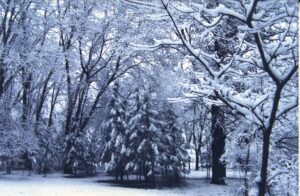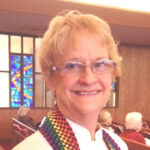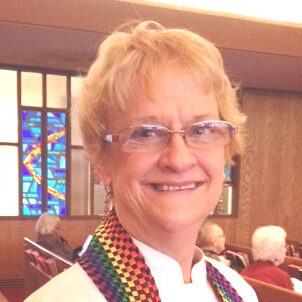Advent: A Blue Christmas
It seems odd that the New Year for Christians starts in the winter, not in the spring. Springtime would be a natural season for new  beginnings when nature is filled to bursting with buds and blossoms of new life. For example, a branch from the Jacaranda tree would be an outstanding symbol of transformation to put on a worship table, with its clusters of fragrant, purple blooms. But instead, Advent, the period when we await once more the birth of Christ in our hearts, begins in the chilly, often foreboding time of year.
beginnings when nature is filled to bursting with buds and blossoms of new life. For example, a branch from the Jacaranda tree would be an outstanding symbol of transformation to put on a worship table, with its clusters of fragrant, purple blooms. But instead, Advent, the period when we await once more the birth of Christ in our hearts, begins in the chilly, often foreboding time of year.
For more than two thousand years, Christians have considered purple as the color for Advent worship. Yes, it is a symbol of royalty, signaling Jesus as “the King of kings.” But it also reminds us of Jesus’ way of ruling by serving, suffering for others’ estrangement and sin.
So if the traditional color for Advent all this time has been purple, why are so many church worship spaces these days draped in blue?
For many of us, when we hear the word “blue” we recall the sorrowful-yet-magnificent music of the blues. We may immediately identify with the phrase, “I’m feeling blue.” Or we recall lines of lyrics from Elvis Presley’s sad song, “Blue Christmas.”
So “blue” says a lot more than just a color. In fact, many congregations these days offer a “Blue Christmas” service on the longest night of the year (the Winter Solstice), which usually takes place on or near December 21st. The worship service is meant for people who are not feeling cheery as they approach the Christmas season. Over this past year they may have been “dealing with the death of a loved one, facing life after divorce or separation, coping with the loss of a job, living with cancer or some other dis-ease that puts a question mark over the future, and a number of other human situations [that] make parties and joviality painful.”1 So these churches provide sacred space for reflection, to acknowledge our dark times and God’s offer of love and hope in their midst.
Blue is also associated with hope, which is one of the four primary themes throughout the four weeks of Advent that prepare for Christmas. So a Blue Christmas service is designed around the hope of Christ, offering us wholeness and healing.
One example is a “Blue Christmas” service adapted by Daniel Benedict from liturgy developed at The Cathedral Church of Saint Andrew in Honolulu. It opens with this affirmation from the Gospel of John: “The Light shines in the darkness, and the darkness has not overcome it.”
At its heart are several Bible texts and a litany of remembrance while the leader lights four candles:
• The first candle to remember those whom we have loved and lost, praying that God’s love now encircles and surrounds them in eternal life.
• The second flame to remember the pain of loss: loss of relationships, of trust, of health, of jobs, of faith, or of joy, remembering that through God, “all things are possible.”
• The third one to remember ourselves after past burdened weeks, months, or years, by declaring that although we may have lost our way in the dark, the Light of Christ has never been extinguished.
• The fourth candle to remember God’s gift of hope through the birth of Jesus Christ, who, like many of us, also began in insecurity, in humbleness and in poverty, but who nevertheless promises both comfort and peace.
That worship service ends with prayers of the people asking for God’s mercy, then sharing Scriptures and blessings with one another in the name of the “gentle God of love.”
A Blue Christmas service of worship may help us understand why the entire Christian Year begins in winter after all. Whatever the reason for our suffering or loss, it is precisely when we are in the winter of our souls that God’s Good News helps us most. When we ache for hope beyond our current situation, we most value the Good News of God’s love and the gift of life made new.
What better beginning can we have to any year than to remember God’s mercy in the places of loss and despair?
Betsy Schwarzentraub
See also: The Spirit of Advent, Being in Advent, Do What for Advent?
1 – Daniel Benedict, https://www.umcdiscipleship.org/resources/blue-christmaslongest-night-worship-with-those-who-mourn


